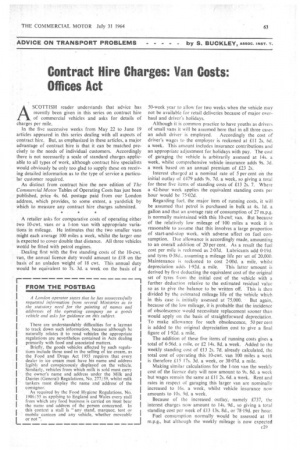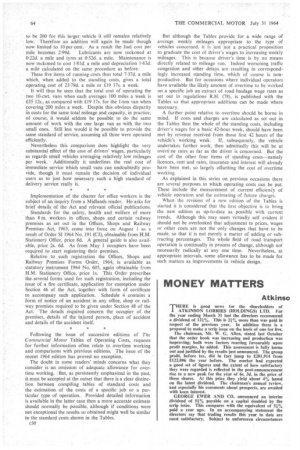Contract Hire Charges: Van Costs: Offices Act
Page 65

Page 66

If you've noticed an error in this article please click here to report it so we can fix it.
ADVICE ON TRANSPORT PROBLEMS by S. BUCKLEY, ASSOC. INST. T.
ASCOTTISH reader understands that advice has recently been given in this series on contract hire of commercial vehicles and asks for details of charges per mile.
In the five successive weeks from May 22 to June 19 articles appeared in this series dealing with all aspects of contract hire. But, as emphasized in these articles, a major advantage of contract hire is that it can be matched precisely to the needs of individual customers. Accordingly there is not necessarily a scale of standard charges applicable to all types of work, although contract hire specialists would obviously be only too glad to supply these on receiving detailed information as to the type of service a particular customer required.
As distinct from contract hire the new edition of The Commercial Motor Tables of Operating Costs has just been published, price 4s. 6d. postage paid from our London address, which provides, to some extent, a yardstick by which to measure any contract hire charges submitted.
A retailer asks for comparative costs of operating either two 10-cwt. vans or a 1-ton van with appropriate variations in mileage. He intimates that the two smaller vans might each average 100 miles a week, whilst the larger one is expected to cover double that distance. All three vehicles wonld be fitted with petrol engines.
Dealing first with the five standing costs of the 10-cwt. van, the annual licence duty would amount to £18 on the basis of an unladen weight of 18 cwt. This annual duty would be equivalent to 7s. 3d. a week on the basis of a
50-week year to allow for two weeks when the vehicle may not be available for retail deliveries because of major overhaul and driver's holidays.
Although it is common practice to have youths as drivers of small vans it will be assumed here that in all three cases
an adult driver is employed. Accordingly the cost of driver's wages to the employer is reckoned at £11 2s. 6d. a week. This amount includes inSurance contributions and an appropriate adjustment for holidays with pay. The cost of garaging the vehicle is arbitrarily assessed at 14s. a week, whilst comprehensive vehicle insurance adds 9s. 3d. a week based on an annual premium of £23 2s.
Interest cha rged at a nominal rate of 5 per cent on the initial outlay of £479 adds 9s. 7d. a week, so giving a total for these five items of standing costs of £13 2s. 7. Where a 42-hour week applies the equivalent standing costs per hour would be 75.02d.
Regarding fuel, the major item of running costs, it will be assumed that petrol is purchased in bulk at 4s. Id. a gallon and that an average rate of consumption of 27 m.p.g. is normally maintained with this 10-cwt van. But because of the relatively low mileage of 100 miles a week it is reasonable to assume that this involves a large proportion of start-and-stop work, with adverse affect on fuel consumption. Due allowance is accordingly made, amounting to an overall addition of 20 per cent. As a result the fuel cost per mile is reckoned as 2-07d. Lubricants add 0.19d. and tyres 0.38d., assuming a mileage life per set of 20,000. Maintenance is reckoned to cost 2.00d, a mile whilst depreciation adds 1.92d. a mile. This latter amount is derived by first deducting the equivalent cost of the original set of tyres from the initial cost of the vehicle with a further deduction relative to the estimated residual value so as to give the balance to be written off. This is then divided by the estimated mileage life of the vehicle which in this case is initially assessed at 75,000. But again, because of the low mileage, it is probable that the incidence of obsolescence would necessitate replacement sooner than would apply on the basis of straightforward depreciation. To make allowance for such obsolescence, 50 per cent is added to the original depreciation cost to give a final figure of 1.92d. a mile.
The addition of these five items of running costs gives a total of 6.56d. a mile, or £2 14s, 8d. a week. Added to the weekly standing cost of £13 2s. 7d. already calculated, the total cost of operating this 10-cwt. van 100 miles a week is therefore £15 17s. 3d. a week, or 38'0'7d. a mile.
Making similar calculations for the 1-ton van the weekly cost of the licence duty will now amount to 9s. 8d. a week but wages remain the same at £11 2s. 6d. a week. Rent and rates in respect of garaging this larger van are nominally increased to 16s. a• week, whilst vehicle insurance now amounts to 10s. 9d. a week.
Because of the increased, outlay, namely /737, the interest charges now amount to 14s. 9d., so giving a total standing cost per week of £13 13s. 8d., or 78.19d. per hour.
Fuel consumption normally would be assessed at 18 m.p.g., but although the weekly mileage is now expected
to be 200 for this larger, vehicle it still remains relatively low. Therefore an addition will again be made though now limited to 10 per cent. As a result the fuel cost per
mile becomes 2.99d. Lubricants are now reckoned at 0.22d. a mile and tyres at 0-52d. a mile. Maintenance is now reckoned to cost 1.81d. a mile and depreciation 1.83d. a mile calculated on the same procedure as before.
These five items of running costs thus total 7-37d. a mile which, when added to the standing costs, gives a total operating cost of 23.79d. a mile or £19 17s. a week.
It will thus be seen that the total cost of operating the two 10-cwt. vans when each averages 100 miles a week is £35 12s., as compared with £19 17s. for the 1-ton van when covering 200 miles a week. Despite this obvious disparity in costs for the same total mileage and capacity, in practice, of course, it would seldom be possible to do the same amount of work with the one large van as with the two small ones. Still less would it be possible to provide the same standard of service, assuming all three were operated efficiently.
Nevertheless this comparison does highlight the very substantial effect of the cost of drivers' wages, particularly as regards small vehicles averaging relatively low mileages per week. Additionally it underlines the real cost of immediate service which small vans can undoubtedly provide, though it must remain the decision of individual users as to just how necessary such a high standard of delivery service really is.
Implementation of the charter for office workers is the subject of an inquiry from a Midlands reader. He asks for brief details of the Act and relevant official publications.
Standards for the safety, health and welfare of more than 8 m. workers in offices, shops and certain railway premises as set out in the Offices, Shops and Railway Premises Act, 1963, come into force on August 1 as a result of Order SI 1964 No. 191 (C3), obtainable from H.M. Stationery Office, price 8d. A general guide is also available, price 2s. 6d. As from May 1 occupiers have been requjred to start registering their premises.
Relative to such registration the Offices, Shops and Railway Premises Forms Order, 1964, is available as statutory instrument 1964 No. 605, again obtainable from H.M. Stationery Office, price Is. This Order prescribes the-several forms used for such registration, including the issue of a fire certificate, application for exemption under Section 46 of the Act, together with form of certificate to accompany such application. Schedule 4 contains a form of notice of an accident in any office, shop or railway premises required to be given under Section 48 of the Act. , The details required concern the occupier of the premises, details of the injured person, place of accident and details of the accident itself.
Following the issue of successive editions of The Commercial Motor Tables of Operating Costs, requests for further information often relate to overtime working and comparisons with previous editions. The issue of the recent 1.964 edition has proved no exception.
The doubt in some readers' minds concerns what they consider is an omission of adequate allowance for overtime working. But, as persistently emphasized in the past, it must be accepted at the outset that there is a clear distinction between compiling tables of standard costs and the estimation of the costs of a specific job or a particular type of operation. Provided detailed information is available in the latter case then a more accurate estimate should normally be possible, although if conditions were not exceptional the results so obtained might well be similar to the standard costs shown in the Tables.
c30 But although the Tables provide for a wide range of average weekly mileages appropriate to the type of vehicles concerned, it is just not a practical proposition to graduate the cost of driver's wages to increasing weekly mileages. This is because driver's time is by no means directly related to mileage run. Indeed worsening traffic congestion and other delays are resulting in correspondingly increased standing time, which of course is nonproductive. But for occasions where individual operators have available the likely amount of Overtime to be worked on a specific job an extract of road haulage wage rates as set out in regulations R.H. (78), is published with the Tables so that appropriate additions can be made where necessary.
A further point relative to overtime should be borne in mind. If costs and charges are calculated as set out in the Tables then the whole of the standing costs, including driver's wages for a basic 42-hour week, should have been met by revenue received from those first 42 hours of the vehicle's working week. If, subsequently, the vehicle undertakes further work, then admittedly this will be at overti ne rates as far as the driver is concerned. But the cost of the other four items of standing costs—namely licences, rent and rates, insurance and interest will already have been met, so largely offsetting the cost of overtime working.
As explained in this series on previous occasions there are several purposes to which operating costs can be put. These include the measurement of current efficiency of vehicle operation and the estimating of future charges.
When the revision of a new edition of the Tables is started it is considered that the first objective is to bring the new edition as up-to-date as possible with current trends. Although this may seem virtually self evident it should not be overlooked that adjustment to prices, wages or other costs are not the only changes that have to be made, so that it is not merely a matter of adding or subtracting percentages. The whole field of road transport operation is continually in process of change, although not necessarily radically at any one time. Nevertheless, at appropriate intervals, some allowance has to be made for such matters as improvements in vehicle design.








































































































